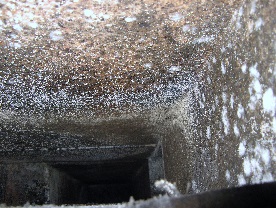Mould removal from air conditioning systems

Mould will colonise almost any available surface once the environmental conditions are right for it to develop. This is equally true for air-conditioning and air supply (HVAC) systems in our homes and workplaces. Mould growing in the HVAC systems is likely to degradation of indoor air quality and complaint form occupants.
Mould growth can occur in HVAC systems when the surface of the ducting becomes dirty and moist. Dirt and mould growth on nonporous sheet metal surfaces can be relatively easily removed by physical cleaning. However, mould growth on porous airstream surfaces cannot be removed by cleaning. Physical removal of the porous material is required once hyphae have penetrated into the porous substrate.When mould growth occurs in HVAC systems, it should be realized that air handling units and supply air ductwork are designed to transport ventilation air directly to the occupant breathing zone. Thus, during mould remediation in HVAC systems it is necessary to prevent dust and mould particles dislodged from airstream surfaces during cleaning from following ventilation pathways into occupied spaces.
Because of the difficulty associated with mould remediation of airstream surfaces in HVAC systems, the manufacture of insulation with an airstream surface that is smooth, cleanable, and resistant to bio-deterioration has been recommended.
The presence of stagnant water in some of the air handling systems and drain pans and in humidifier water reservoirs provides conditions for the formation of bio-film (slime containing yeasts, bacteria, protozoa, and other microorganisms) on submerged or wet surfaces.
Procedures for removal of bio-film from air handling units and humidifiers include decommissioning of the HVAC component or device, physical removal of the bio-film aided by use of detergents and disinfectants, removal of cleaning chemicals, and re-commissioning of the HVAC component or humidifier.
The use of biocides in place of routine physical removal of bio-film through cleaning is inappropriate. Prevention of bio-film development in HVAC components is promoted by sloping of drain pans for self-drainage, periodic cleaning of cooling coils and wet surfaces and design of HVAC components for accessibility of potentially wet surfaces for ease of inspection and maintenance.
